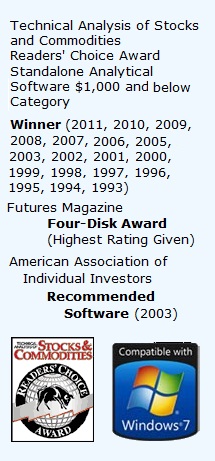Pre-Programmed Functions – Discover Nesting Functions
How good are you when it comes to pre-programmed functions? You are now reading the continuation of our series on the basics of MetaStock Programming Language and Metastock tips. In this post we are going to go through nesting functions and alert functions that any Metastock Expert should know. With so many functions available within MetaStock it’s important to note that functions can be ‘nested’ within a function. That is, a nested function can act as another function’s data array parameter. For example, assume you wanted to code the moving...
read morePre-Programmed Functions – Learn The Pasting Functions
This is a continuation of our series on the basics of MetaStock Programming Language and Metastock tips. In this post we are going to go through pasting functions any Metastock Expert should know. As you could imagine with over 200 pre-programmed functions it would be next to impossible to memorise every parameter and its correct syntax. As such Metastock has included a ‘Paste Functions’ dialog box. This allows you to paste the correct syntax straight into any formula you may be working on. Simply by clicking the functions button while...
read morePre-Programmed Functions – Introduction For Metastock Experts
This is a continuation of our series on the basics of MetaStock Programming Language and Metastock tips. In this post we are going to go through pre-programmed functions any Metastock Professional should know. Introduction In addition to the mathematical operators there are over 200 pre-programmed functions to allow coding versatility. The bulk of these fall into three categories: analysis tools, indicators and candlesticks. In this chapter we’ll look at each of these categories in detail, highlighting some of the more commonly used...
read moreMetaStock Programming Language – Exercises
This is a continuation of our series on the basics of MetaStock Programming Language and Metastock tips. In this post we are going to test your knowledge as a Metastock Expert by completing the following. Price Array Identifier Shortcut Open High Low Close Volume Arithmetic Operators Shortcut Division Multiplication Addition Subtraction Comparison Operators Shortcut Less than Less than or equal to Greater than Greater than or equal to Equal to Not equal to Some of the...
read moreMetaStock Programming Language – Input ‘On Balance Volume Indicator’
This is a continuation of our series on the basics of MetaStock Programming Language and MetaStock market data. In this post we are going to talk about ‘On Balance Volume Indicator’, something that you need to know as a Metastock Expert. Figure 2.8 –Input ‘On Balance Volume’ Indicator When looking at the code, can you identify each separate component of the input function? i.e the prompt text, minimum value, maximum value and default value. The astute reader may have realised that inputs are most effective when used in conjunction...
read moreMetaStock Programming Language – Rules In Naming Variables
This is a continuation of our series on the basics of MetaStock Programming Language. In this post we are going to talk about tips in naming variables as a Metastock Professional. When naming variables, MetaStock outlines that there are a few rules to follow: • Variable names cannot contain commas, parenthesis, spaces, underscores etc. • Variable names cannot duplicate names already used by functions (e.g., mov, rsi, if, etc.). • Variables cannot be assigned a name that matches the parameters reserved for use in formulas (e.g., open,...
read moreMetaStock Programming Language – Tips On Inserting Comments
This is a continuation of our series on the basics of MetaStock Programming Language. In this post we are going to talk about inserting comments within a formula. Inserting Comments MetaStock allows you to make comments anywhere within a formula. Comments are denoted by enclosing any text in braces i.e. ‘{’ and ‘}’. These make it possible to annotate your code without wrecking the syntax. Ultimately, as a Metastock expert this makes code easier to read by yourself and others. Moreover, comments are a great tool when used in the design phase...
read moreLearning The Basics Of MetaStock Programming Language Part 3
This is a continuation of our series on the basics of MetaStock Programming Language. In this post we are going to talk about the order of precedence and periodicity. Order of Precedence The order of operator precedence specifies the standard order to be used when calculating any mathematical expression. That is to say, when using any of the mathematical operators we’ve described previously, there’s a universally agreed-upon order in which to evaluate them. You may recall learning this in basic arithmetic classes, however let’s refresh our...
read moreLearning The Basics Of MetaStock Programming Language Part 2
This is a continuation of our series on the basics of MetaStock Programming Language. In this Metastock guide post we are going to talk about the mathematical and logical operators. Mathematical Operators ‘Mathematical Operators’ is just a fancy name for basic mathematical terms used within coding. These can be broken into three categories: arithmetic operators, comparison operators and logical operators. Do you remember basic arithmetic from school? Table 2.2 lists the arithmetic operators and their corresponding coding shortcuts. Arithmetic...
read moreLearning The Basics Of MetaStock Programming Language Part 1
Introduction To The MetaStock Programming Language MetaStock uses a patented programming language that, to the untrained eye, seems more like a foreign language. Some users have even affectionately named it ‘MetaSpeak’. At first glance it may look intimidating, but MetaStock is quite logical in its processes. Consequently, anyone with a bit of persistence can learn to program custom indicators, explorations, system tests and experts. In fact, you don’t have to be a MetaStock expert just to get started. MetaStock’s programming language...
read more


